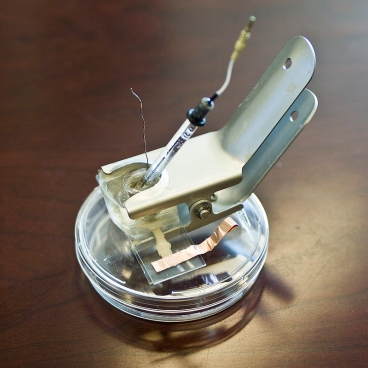Self-assembling photovoltaic technology can keep repairing itself
September 7, 2010

This proof-of-concept version of the photoelectrochemical cell, which was used for laboratory tests, contains a photoactive solution made up of a mix of self-assembling molecules (in a glass cylinder held in place by metal clamp) with two electrodes protruding from the top, one made of platinum (the bare wire) and the other of silver (in a glass tube). (Patrick Gillooly)
MIT scientists have created a novel set of self-assembling molecules that can turn sunlight into electricity; the molecules can be repeatedly broken down and then reassembled quickly, just by adding or removing an additional solution.
In an attempt to imitate the process of photosynthesis, Michael Strano, the Charles and Hilda Roddey Associate Professor of Chemical Engineering, and his team, supported by grants from the MIT Energy Initiative, the Eni Solar Frontiers Center at MIT and the Department of Energy, produced synthetic molecules called phospholipids that form disks; these disks provide structural support for other molecules that actually respond to light, in structures called reaction centers, which release electrons when struck by particles of light.
The disks, carrying the reaction centers, are in a solution where they attach themselves spontaneously to carbon nanotubes — wire-like hollow tubes of carbon atoms that are a few billionths of a meter thick yet stronger than steel and capable of conducting electricity a thousand times better than copper. The nanotubes hold the phospholipid disks in a uniform alignment so that the reaction centers can all be exposed to sunlight at once, and they also act as wires to collect and channel the flow of electrons knocked loose by the reactive molecules.
The system Strano’s team produced is made up of seven different compounds, including the carbon nanotubes, the phospholipids, and the proteins that make up the reaction centers, which under the right conditions spontaneously assemble themselves into a light-harvesting structure that produces an electric current. Strano says he believes this sets a record for the complexity of a self-assembling system. When a surfactant — similar in principle to the chemicals that BP has sprayed into the Gulf of Mexico to break apart oil — is added to the mix, the seven components all come apart and form a soupy solution. Then, when the researchers removed the surfactant by pushing the solution through a membrane, the compounds spontaneously assembled once again into a perfectly formed, rejuvenated photocell.
“We’re basically imitating tricks that nature has discovered over millions of years” — in particular, “reversibility, the ability to break apart and reassemble,” Strano says. The team, which included postdoctoral researcher Moon-Ho Ham and graduate student Ardemis Boghossian, came up with the system based on a theoretical analysis, but then decided to build a prototype cell to test it out. They ran the cell through repeated cycles of assembly and disassembly over a 14-hour period, with no loss of efficiency.
Strano says that in devising novel systems for generating electricity from light, researchers don’t often study how the systems change over time. For conventional silicon-based photovoltaic cells, there is little degradation, but with many new systems being developed — either for lower cost, higher efficiency, flexibility or other improved characteristics — the degradation can be very significant. “Often people see, over 60 hours, the efficiency falling to 10 percent of what you initially saw,” he says.
The individual reactions of these new molecular structures in converting sunlight are about 40 percent efficient, or about double the efficiency of today’s best solar cells. Theoretically, the efficiency of the structures could be close to 100 percent, he says. But in the initial work, the concentration of the structures in the solution was low, so the overall efficiency of the device — the amount of electricity produced for a given surface area — was very low. They are working now to find ways to greatly increase the concentration.
More info: MIT news